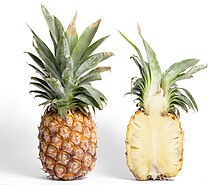anthocarp
Jump to navigation
Jump to search
English
[edit]
The flower of Neea laxa, in the family Nyctaginaceae, instead of being shed, will form part of the anthocarp that includes the true fruit


Etymology
[edit]Noun
[edit]anthocarp (plural anthocarps)
- (botany) Any of various forms of fruits in which part of the perianth tissue remains attached to the fruit, as part of the mechanism of dispersal.
- (botany) Lower part of a perianth containing the fruit, the upper part having dropped away, well seen in plants of the family Nyctaginaceae.[1]
- (botany) In the Nyctaginaceae, individual apetalous flowers have a tubular, petaloid calyx that resembles a sympetalous corolla. The lower portion of the calyx tightly enwraps the one-seeded achene and is persistent around the fruit as an anthocarp. The calyx base plus the enclosed seed-bearing achene is the unit of dispersal.[2]
- (botany) A collective, composite or aggregated fruit formed from an entire inflorescence, as in the sorosis of a pineapple or the syconus of a fig.[3]
- (botany) A fruit resulting from many flowers, such as the pineapple; a fruit of which the perianth or the torus forms part.[4]
- (botany) A composite false fruit, consisting of the actual fruit and the perianth.[5]
- (botany) A fruit formed by the union of the floral organs or part of them, with the fruit itself, as in Nyctagineae; also applied to fruits with accessories, sometimes termed pseudocarps, as the strawberry and pineapple.[6]
See also
[edit]References
[edit]- ^ Chittenden, Fred J. Ed., Royal Horticultural Society Dictionary of Gardening, Oxford 1951
- ^ “Archived copy”, in (Please provide the book title or journal name)[1], 2019 September 7 (last accessed), archived from the original on 29 June 2019
- ^ [2]
- ^ Allied Chambers (1998) The Chambers Dictionary[3], Allied Publishers, →ISBN, pages 63–
- ^ Collins English Dictionary – Complete and Unabridged, 12th Edition 2014
- ^ Jackson, Benjamin, Daydon; A Glossary of Botanic Terms with their Derivation and Accent; Published by Gerald Duckworth & Co. London, 4th ed 1928

One entire pineapple infructescence and one vertical section through one; each projection on the yellow mass is the tip of one fruit in the infructescence.

Vertical section through two fruit in a pineapple infructescence, showing the remnants of the perianths at their tips